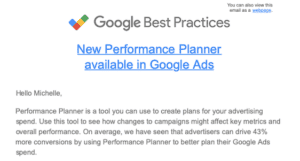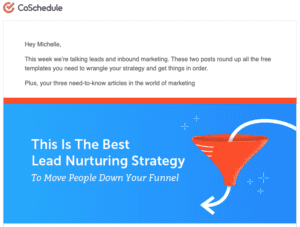Dynamic email marketing is on the scene to save you from losing subscribers (and potential sales) because of one bad email. We’ve all received poorly done automated emails that don’t have the right name or they contain information that’s irrelevant to our interests, and we end up not checking future emails and/or unsubscribing from that brand because of just one bad email. As a result, email marketing metrics like views, CTR, and subscription numbers begin to look not so hot. However, there’s a way you can begin to write your emails that’ll help engage your users and keep them connected to the brand all while delivering relevant and timely content.
The more effectively you’re able to personalize your email content to your recipients, the more successful your email campaign will end up being. Personalization can be a bit on the challenging side, especially since it can be very time-consuming if you’ve built a large email list. It’s for this reason ( and a lot of others) that you should begin creating dynamic email content if you haven’t already.
What is Dynamic Email Content?

Dynamic email content is content that you create using HTML that pulls specific information from the end user to personalize your content. For instance, adding a merge tag in your email service provider will allow you to implement the first name of the recipient into your message. A merge tag is the placeholder code that gets replaced with your recipients’ information when it gets sent out.
This is just a basic form of dynamic content. Different dynamic email content software solutions can use different information to tailor your emails to your recipients. The following are just a few ways you can improve personalization using dynamic content:

- Emails based on demographics. Customer accounts typically contain a vital amount of information: name, age, location, and gender identity. This information can be used to fill in bits of the email and help segment your audience based on what you know about particular demographics and their interest or buying behaviors as a group. We can see Michelle’s name replaced in this email from CoSchedule using a merge tag.

- Emails based on behaviors. Email triggering systems can paste snippets of code onto your website that will track the behavior of your email recipients. You can then identify what behaviors are most important for driving conversions and automate specific email content to be triggered based on certain actions.
For example, if a recipient has added something to their shopping cart but has abandoned it, you could send an email asking if they forgot or even offering a small discount to encourage them to check out. Uh oh, it looks like Michelle hasn’t been around in a year and this company is reaching out to see if she wants to engage with them again.
- Emails based on opt-in information. You can gather a lot of information from your recipients through the email opt-in form.
Example, if you run a pet food company, you could ask what kind of pet the recipient owns. Let’s say you decide to have a storewide sale on pet food and want to send a notice of this sale. With dynamic content, you can write several emails based on specific pet food (such as dog food, cat food, and fish food) that are then sent based on the information the recipient provided about their pets. This means that a sales notice on dog food would only be sent to dog owners, cat food to cat owners, etc.
![]()
- Emails based on purchasing history. Using dynamic email content, you can send follow up emails based on the products a customer has purchased.
For example, a few days after making a purchase, you could send your recipient content focusing on how to use the product they bought most effectively. If you sell tickets to events, you could send a reminder email about the event as well as information about that specific event a day or two before the event is set to take place.
This can all be automated based on the use of dynamic email content. I love a sale and Expedia knows it. Emails like this get me to click faster than any generic ad I’ve ever gotten because they know I’ll most likely bite and click through to read.
These are just a few examples of how dynamic email content can allow you to personalize your emails more effectively. You can view this graphic from VentureBeat to see some of the many other ways you could segment your audience in preparation for some dynamic email content.
The Benefits of Using Dynamic Email Content
If you’re wondering whether the benefits of dynamic email content are really worth the investment when compared to standard static email content, then just consider the following advantages of using dynamic email content:
- Improve marketing efficiency. Manually segmenting and targeting different sections of your email list with different messages can be incredibly time-consuming. The use of dynamic email content can help to drastically cut down how long it takes to personalize email content in this way, thereby potentially saving you a significant amount of money as well. The time you would have spent manually segmenting your email list can be spent on planning your email content and activity instead.
- Improve engagement. When email content is tailored more to the recipient’s needs and behavior, they are more likely to engage by following your calls-to-action by up to 14%. It will also help ensure that they will continue opening your emails. When email content isn’t personalized and ends up not being relevant to the recipient, they are more likely to ignore future emails or, even worse, unsubscribe.
- Improve conversions. The ability to use dynamic content to target recipients based on past purchasing behavior can help you recommend relevant products and services, thereby improving conversions and increasing sales. Personalized emails can increase transaction rates up to 6 times their normal.
- Build brand loyalty. By sending content that’s actually relevant and personalized to your recipient, you’ll build brand loyalty. They will become more likely to make additional purchases as well as to recommend your brand to friends and family as a result, thereby becoming brand ambassadors.
Where do I start?
Once you understand what dynamic email content and the benefits of it are you have to begin setting it up. Most email campaign platforms such as MailChimp, SharpSpring, and Hubspot allow you to set up campaigns with dynamic content. Follow these steps to begin the process of setting up dynamic emails:
- Outline your campaign strategy. Regardless of whether you’re writing a single email campaign or series you want to understand just who in your audience it would appeal to. Are you launching a new women’s product line? Is it a re-marketing campaign effort with the goal to bring back past clients? Once you begin understanding the strategies and goals of your campaign you can move onto the next step.
- Segment your audience. Next, who does your campaign appeal to? You might be launching a product that’s only appearing at stores within Texas. Or, you might have a policy change due to a change in laws in the state of South Carolina. If you’re able to segment your audience by location and target those specific regions of the county you can ensure only they receive those emails. If not, you might have several thousand people receiving an email that isn’t relatable. Some tools such as SharpSpring even allow you to create dynamic content based on user personas.
- Send your first email. Finally, you get to craft your email, insert the dynamic content areas and the information that goes within them.
- Celebrate. You’ve done it! Email marketing is easier than ever before! Now, you’ll hopefully be able to accomplish those email marketing conversion goals you’ve been working towards.
If you’re wondering whether the benefits of dynamic email content are really worth the investment when compared to standard static email content, then just consider the repercussions you might face if you continue to send out blanket emails. People will lose interest and they often won’t come back.
The bottom line is that the use of dynamic content will help greatly improve the effectiveness of your email marketing campaign. You’re able to engage your audience in ways that are relevant to their needs and interests in the moment without clogging their inboxes with emails that they could care less about.
Now, how do you turn your dynamic emails into an engaging email campaign? Check out our 4 Best Practices of Sending a Responsive Automated Email Campaign blog to learn more.
-FINAL(01-00)-White&Blue-01.svg)





